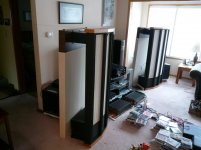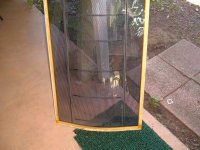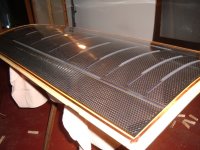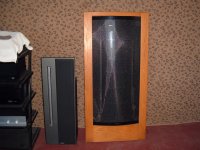Dual, front and rear firing Acoustats need explanation
So curiosity got the better of me. I put a pair of Model 3 directly behind the Monitor 3, firing in the opposite direction, separately powered. To my delight, they sound phenomenal this way. I've been listening to them like this for a couple weeks now. So I'm assuming the diplole effect is cancelled because of the close proximity and rear firing renders the combo 360 deg dispersion? It seems like the diaphragms are acting against/boosting each other and thereby causing higher sensitivity/efficiency? What I hear are greater dynamics and much deeper sound stage.
I'm hoping someone will be willing to explain this ignorant endeavor technically
So curiosity got the better of me. I put a pair of Model 3 directly behind the Monitor 3, firing in the opposite direction, separately powered. To my delight, they sound phenomenal this way. I've been listening to them like this for a couple weeks now. So I'm assuming the diplole effect is cancelled because of the close proximity and rear firing renders the combo 360 deg dispersion? It seems like the diaphragms are acting against/boosting each other and thereby causing higher sensitivity/efficiency? What I hear are greater dynamics and much deeper sound stage.
I'm hoping someone will be willing to explain this ignorant endeavor technically
Attachments
Last edited:
Hi Did
Fascinating arrangement and not quite sure that your description of cancelling and boosting is correct, unless you are running each pair out of phase with each other.
So, if you are running them in phase, they are adding to each other (as the arrangement you show is with them back to back) in the area between each set of panels. Outside the panels, to the sides, the dipole cancelation is broadened, but behind you have a bipolar dispersion. Additionally this will change with frequency on the basis of the width of the panels. So would be keen to hear what knowledgeable people think of this. The later point regarding frequency balance effects as a function of width, has always puzzled me regarding why the standard stacked multi-panel systems had the same bass balance as the wider, similar number of panelled systems. Great set up anyway and would be keen to also hear what size room and proximity to back wall you are running the set up in.
Kind Regards
Grant
Fascinating arrangement and not quite sure that your description of cancelling and boosting is correct, unless you are running each pair out of phase with each other.
So, if you are running them in phase, they are adding to each other (as the arrangement you show is with them back to back) in the area between each set of panels. Outside the panels, to the sides, the dipole cancelation is broadened, but behind you have a bipolar dispersion. Additionally this will change with frequency on the basis of the width of the panels. So would be keen to hear what knowledgeable people think of this. The later point regarding frequency balance effects as a function of width, has always puzzled me regarding why the standard stacked multi-panel systems had the same bass balance as the wider, similar number of panelled systems. Great set up anyway and would be keen to also hear what size room and proximity to back wall you are running the set up in.
Kind Regards
Grant
Hi Did
Fascinating arrangement and not quite sure that your description of cancelling and boosting is correct, unless you are running each pair out of phase with each other.
So, if you are running them in phase, they are adding to each other (as the arrangement you show is with them back to back) in the area between each set of panels. Outside the panels, to the sides, the dipole cancelation is broadened, but behind you have a bipolar dispersion. Additionally this will change with frequency on the basis of the width of the panels. So would be keen to hear what knowledgeable people think of this. The later point regarding frequency balance effects as a function of width, has always puzzled me regarding why the standard stacked multi-panel systems had the same bass balance as the wider, similar number of panelled systems. Great set up anyway and would be keen to also hear what size room and proximity to back wall you are running the set up in.
Kind Regards
Grant
I tried them out of phase and that just sucks the life right out of the sound but the opposite happens when they are in phase. By saying they cancell the dipole effect, I meant that over all, there is a resultant 180 deg. X2 or 360 deg bi-polar effect. By boost, I mean that it seems the membranes are bucking against each other resulting in a stronger/more forceful action as if like in a dynamic speaker motor, a higher flux density results in a stronger field against the vc. I'm thinking there is an optimal distance between them. I want to remove the panels from the Model 3 and put them on a more diminutive frame with the interfaces on the floor. That way I can get them much closer to each other and move them a little at a time to discover the best distance. The front facing Monitor 3 are 45" from the back wall and the Model 3 are 29", measured from the actual panels. They are 8' apart. The room is open from the left speaker to the dining area, about 5' to the wall from the right speaker. Front and back walls are 17' apart.
Yes, that makes sense and the experimentation may provide a better understanding of the mechanisms at play. I hope someone can add some technical input to explain what you are hearing and worth taking some time to evaluate if there are any negatives in terms of time domain issues, upper harmonics and response fluctuations associated with the spacing.
Best Wishes
Grant
Best Wishes
Grant
I tried a similar experiment with Magnepans, with the rear panel at 90 degrees to the listening axis, emulating the SME arrangement.
Bass an midrange energy raised, along with some room nodes. Imaging wasn't better. I used two identical stereo amps to drive it all.
"FrankenPan"
http://www.quadesl.org/index.php/hard-core/stacked-quads
Sent from my Nexus 6 using Tapatalk
Bass an midrange energy raised, along with some room nodes. Imaging wasn't better. I used two identical stereo amps to drive it all.
"FrankenPan"
http://www.quadesl.org/index.php/hard-core/stacked-quads
Sent from my Nexus 6 using Tapatalk
Last edited:
hmm should be less then ideal if you ask me in phase would work beter but at mid high ferq they should be WAAAAAY closer. try filtering the back one then run them out of phase, then you will get a boost.
Hi Winrex
I think with them mounted back to back and the "interfaces" wired in phase, the panels are out of phase.
Cheers
Grant
Hi Winrex
I think with them mounted back to back and the "interfaces" wired in phase, the panels are out of phase.
Cheers
Grant
yeah something you dont want actually. so out phase would result in phase panels
yeah something you dont want actually. so out phase would result in phase panels
Well as I said when I reversed polarity in the Model 3 interfaces there was serious cancellation. This way it's just like more of everything. The sound is 'stronger' for lack of a better term. Attack is harder, decay is more complete, the recording 'room' is louder. Like a more sensitive mic was used.
Ok there is some confusion now  if the panels are back to back and wired normally one membrane would be out of phase. this would result in crap sound overal especially down low. if you reverse polarity of one panel (back one) the membranes are IN phase since one of the panels is the wrong way around.
if the panels are back to back and wired normally one membrane would be out of phase. this would result in crap sound overal especially down low. if you reverse polarity of one panel (back one) the membranes are IN phase since one of the panels is the wrong way around.
with back to back one needs to be out of phase, and the back panels should only be fed frequencys lower then half a wavelength distance to the front membrane (after that the the 2 panels will cancel each other instead of adding).
so for instance if the panels are 30 cm apart membrane to membrane, 344/0.3 meter = 1146 Hz divided by 2 to get half a wavelength is 573 Hz. the back one should not produce anything higher then 573. in this way you gain 6 dB under 573 Hz. if you would let it play fullrange you wil get out of phase material lowering the output at a full wavelength around 1146 and form a comb filter from there and up. so many dips and peaks.
since these panels are already eqed for the rise of 6dB for each octave the only usefull thing would beto see where it drops in the low end and and let the back panel play in this range so it can balance the low end and gives you some more Oempf (as a sub). or do all the eq/sengelentation from scratch to create a flat response.
with back to back one needs to be out of phase, and the back panels should only be fed frequencys lower then half a wavelength distance to the front membrane (after that the the 2 panels will cancel each other instead of adding).
so for instance if the panels are 30 cm apart membrane to membrane, 344/0.3 meter = 1146 Hz divided by 2 to get half a wavelength is 573 Hz. the back one should not produce anything higher then 573. in this way you gain 6 dB under 573 Hz. if you would let it play fullrange you wil get out of phase material lowering the output at a full wavelength around 1146 and form a comb filter from there and up. so many dips and peaks.
since these panels are already eqed for the rise of 6dB for each octave the only usefull thing would beto see where it drops in the low end and and let the back panel play in this range so it can balance the low end and gives you some more Oempf (as a sub). or do all the eq/sengelentation from scratch to create a flat response.
Last edited:
Perhaps reflections off the back wall are somewhat skewing the true effect? All I know is what I hear. I've spent a good deal of time A/B ing the different possible combinations. I keep arriving at this one as the best. I suppose it's possible the interfaces/OTLs are wired internally with opposite polarity normally. That could explain why it's best with the interfaces in phase at the outputs.Ok there is some confusion nowif the panels are back to back and wired normally one membrane would be out of phase. this would result in crap sound overal especially down low. if you reverse polarity of one panel (back one) the membranes are IN phase since one of the panels is the wrong way around.
with back to back one needs to be out of phase, and the back panels should only be fed frequencys lower then half a wavelength distance to the front membrane (after that the the 2 panels will cancel each other instead of adding).
so for instance if the panels are 30 cm apart membrane to membrane, 344/0.3 meter = 1146 Hz divided by 2 to get half a wavelength is 573 Hz. the back one should not produce anything higher then 573. in this way you gain 6 dB under 573 Hz. if you would let it play fullrange you wil get out of phase material lowering the output at a full wavelength around 1146 and form a comb filter from there and up. so many dips and peaks.
since these panels are already eqed for the rise of 6dB for each octave the only usefull thing would beto see where it drops in the low end and and let the back panel play in this range so it can balance the low end and gives you some more Oempf (as a sub). or do all the eq/sengelentation from scratch to create a flat response.
If the back panels are wired in phase....then what sound comes off the back wall would be out of phase with the front...right...
But I have owned the servos amps an thay have pos-neg amp input....it a high/low type setup ...with RCAs inputs also.. that can be used from the preoutputs from preamp also.....but what is the preamps phase?? Not sure about the servos....but I would think its the same as the 121 interfaces .
But this dose not matter....if it sound good it got be right...well to me anyway
But I have owned the servos amps an thay have pos-neg amp input....it a high/low type setup ...with RCAs inputs also.. that can be used from the preoutputs from preamp also.....but what is the preamps phase?? Not sure about the servos....but I would think its the same as the 121 interfaces .
But this dose not matter....if it sound good it got be right...well to me anyway
If the back panels are wired in phase....then what sound comes off the back wall would be out of phase with the front...right...
But I have owned the servos amps an thay have pos-neg amp input....it a high/low type setup ...with RCAs inputs also.. that can be used from the preoutputs from preamp also.....but what is the preamps phase?? Not sure about the servos....but I would think its the same as the 121 interfaces .
But this dose not matter....if it sound good it got be right...well to me anyway
Yeah, the Oppo direct with the OTLs and the Meridian 501 with the interfaces may collectively be out of phase. But I know what out of phase sounds like and this is not it.
Ok there is some confusion nowif the panels are back to back and wired normally one membrane would be out of phase. this would result in crap sound overal especially down low. if you reverse polarity of one panel (back one) the membranes are IN phase since one of the panels is the wrong way around.
with back to back one needs to be out of phase, and the back panels should only be fed frequencys lower then half a wavelength distance to the front membrane (after that the the 2 panels will cancel each other instead of adding).
so for instance if the panels are 30 cm apart membrane to membrane, 344/0.3 meter = 1146 Hz divided by 2 to get half a wavelength is 573 Hz. the back one should not produce anything higher then 573. in this way you gain 6 dB under 573 Hz. if you would let it play fullrange you wil get out of phase material lowering the output at a full wavelength around 1146 and form a comb filter from there and up. so many dips and peaks.
since these panels are already eqed for the rise of 6dB for each octave the only usefull thing would beto see where it drops in the low end and and let the back panel play in this range so it can balance the low end and gives you some more Oempf (as a sub). or do all the eq/sengelentation from scratch to create a flat response.
To your point, it is from lower mid range down that I hear an additive effect. But with that I do hear a loss up higher. The Monitor 3 by themselves is where I hear the flattest response. Which makes me wonder if I should build a structure to enable an incremental adjustment much closer to the front panels. What direction would response likely take? Right now they are 36cm apart. Can I expect a linear change in response with distance?
I love the flat response but I really like that strong enhanced presence.
Last edited:
One thing ....people that have not heard the Acoustat D/d servo tube amps...even the stock amps with old tubes.....an only heard the 121 interfaces....I would say they be shocked......by the Big tone tube magic.....that can come out of these old panels..
Honestly, I think they give anything a run for the money regardless of price. You have not heard ESLs til you've heard them driven directly.
Remarkable difference between the Monitor 3/Model 3 with and without interfaces/DD OTLs.
Today I am running a pr of Model 4s on there 121-a with new bias caps an diodes...
with a 20 watt tube amp....an it sounds great....
But these 4s with a pr of re-worket servos amps.....WoW....... for what $18-2500 a pr can be had...an thay will work with any ESL....just working on putting my last ML CLS panels..... Pure Copper Charge-Diffusion Ring on the mylar....love to hear the CLS panels on the servos...
with a 20 watt tube amp....an it sounds great....
But these 4s with a pr of re-worket servos amps.....WoW....... for what $18-2500 a pr can be had...an thay will work with any ESL....just working on putting my last ML CLS panels..... Pure Copper Charge-Diffusion Ring on the mylar....love to hear the CLS panels on the servos...
Attachments
Disco Pete: Rob MacKinlay of ER Audio here in Australia was developing a dual layer stat panel along the principles of what you have jerry rigged with your Model 3 set up. He told me at the time it had great potential to strengthen the sound field of stats and give a positive result in the manner you are describing with yours. Not sure Rob proceeded with the concept though? It was a few years ago we discussed all of this ...
Cheers,
Steve.
Cheers,
Steve.
- Status
- This old topic is closed. If you want to reopen this topic, contact a moderator using the "Report Post" button.
- Home
- Loudspeakers
- Planars & Exotics
- Dual, front and rear firing Acoustats



